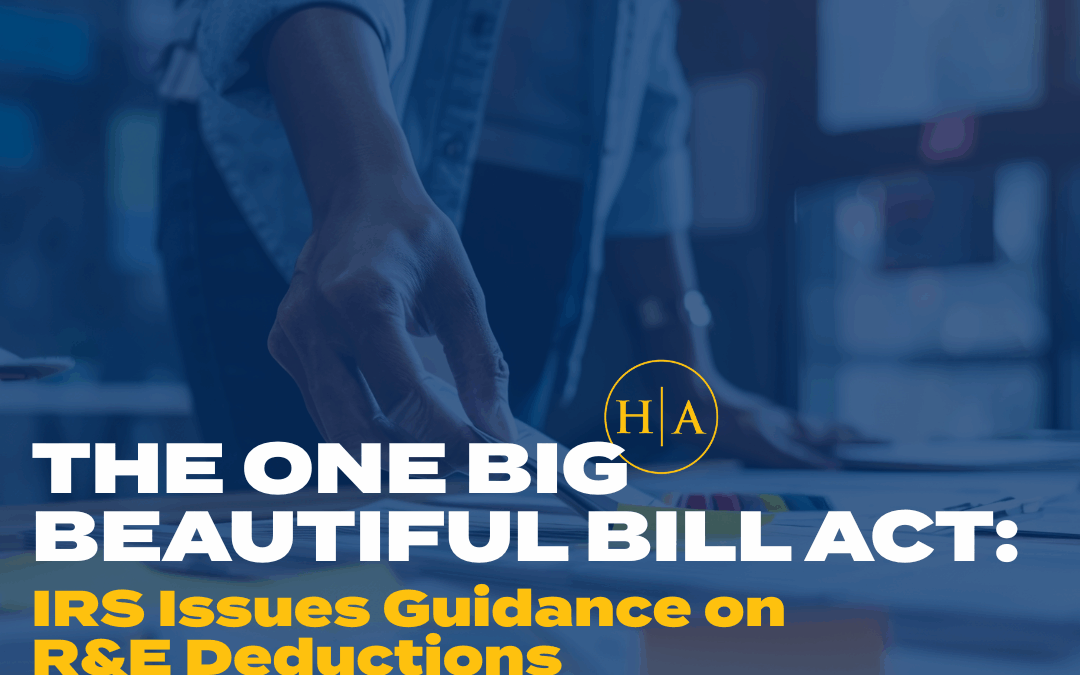The OBBBA brings back some of the most generous business tax breaks we’ve seen in years. If you’re thinking about buying equipment, expanding operations, or investing in research, these changes could save you significant money.
Research and Development Gets Immediate Relief
Effective January 1, 2025, you can immediately expense domestic research and experimental costs instead of spreading them over five years.
What qualifies:
- Research expenses in connection with your trade or business
- Product development costs
- Experimental activities
Foreign vs. domestic:
- Domestic research: Immediate expensing allowed
- Foreign research: Must be spread over 15 years
Planning option: You can elect to spread domestic research costs over at least 60 months if that’s better for your tax situation.
Small business retroactive relief: If your average annual gross receipts are under $31 million, you can retroactively apply these rules to any tax year after December 31, 2021. You have until July 4, 2026, to make this election on an amended return.
Enhanced Qualified Business Income (QBI) Deduction
Starting in 2026, the pass-through deduction gets better and becomes permanent:
Higher phase-in thresholds:
- Single/head of household: Increases from $50,000 to $75,000
- Married filing jointly: Increases from $100,000 to $150,000
New minimum deduction: $400 for taxpayers with at least $1,000 of QBI from active businesses where you materially participate (adjusted annually for inflation).
Business Interest Deduction Relief
For 2025, the business interest limitation calculation goes back to the more generous EBITDA method (earnings before interest, taxes, depreciation, and amortization) instead of the restrictive EBIT method.
What this means: You can deduct more business interest because depreciation and amortization are added back to your income for the calculation.
Excess Business Loss Rules Become Permanent
The rules limiting business losses for individual taxpayers are now permanent:
The limits for 2025:
- $313,000 for single filers, head of household, and married filing separately
- $626,000 for married filing jointly
How it works: If your business losses exceed these amounts, the excess becomes a net operating loss that carries forward to future years.
100% Bonus Depreciation Is Back
Starting January 20, 2025, you can write off the full cost of qualifying business assets in the year you buy them – a jump from the previous 40% limit.
What qualifies:
- Equipment with a useful life of 20 years or less (computers, machinery, furniture, fixtures)
- Most business vehicles
- Computer software with a 3-year depreciation life
- MACRS water utility property
- Films and theatrical productions
The timing matters:
- Assets purchased after January 19, 2025: 100% bonus depreciation
- Assets purchased before January 20, 2025: Still limited to 40%
Contract timing caveat: If you signed a binding purchase contract before January 19, 2025, you don’t get the 100% write-off even if you receive the asset after that date. You’re stuck with the 40% rate (or 20% if placed in service in 2026).
Why this matters: Bonus depreciation works whether your business is profitable or not, and it applies to both new and used assets. It’s automatic unless you elect out.
Section 179 Nearly Doubles
The Section 179 deduction jumps to $2.5 million for 2025 – nearly double the previous limit.
What’s different from bonus depreciation:
- Flexibility: You can pick and choose which assets to expense under Section 179, while bonus depreciation is all-or-nothing by asset class
- Real estate improvements: Section 179 includes certain real estate improvements that bonus depreciation doesn’t
- State tax benefits: Some states allow Section 179 but not bonus depreciation
The limitations:
- Can’t create or increase a business loss (limited to business income)
- Generally not available for rental properties
- Phases out for large asset purchases
Making These Changes Work for You
The return of 100% bonus depreciation creates a huge opportunity for equipment purchases, but timing is critical. If you’re planning major purchases, make sure contracts are signed after January 19, 2025, to get the full benefit.
Section 179 gives you more control – you can strategically choose which assets to expense based on your current year income and state tax situation. The higher limits mean more flexibility for larger purchases.
The research and development changes provide immediate relief if you’ve been capitalizing these costs. Small businesses should seriously consider the retroactive election if it benefits their situation.
For the QBI deduction improvements starting in 2026, consider whether timing business income or expenses might help you optimize this benefit, especially with the new minimum deduction for active business owners.




